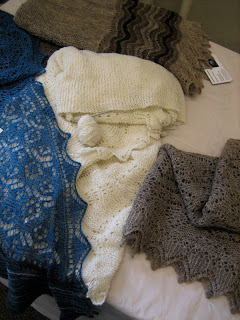Fair Isle for Handspinners -
Exploring color through fiber blending, dyeing, spinning and knitting.
October 26-28, 2012
Garrison Hall, Fort Casey Inn, Whidbey Island, WA
Instructors:
Elizabeth Johnston
Shetland, UK
Martha Owen
John C Campbell Folk School, NC
Join us for this great class coming up this fall on Whidbey Island, just north of Seattle. Elizabeth and Martha will be making their second trip out to the Pacific Northwest. Both came in 2010 and taught two classes, one on knitting and spinning for Shetland lace on Whidbey Island and the other on knitting Fair Isle at the Nordic Heritage Museum in Ballard.
 |
| Greenbank Farm |
The class will be held from Friday, October 26 - Sunday, October 28, 2012 at the Greenbank Farm in central Whidbey Island, WA. This historic former loganberry farm sits on 151 acres of farmland with views of the water from two directions. The farm hosts the Whidbey Pie Cafe, several art galleries, a wine shop and an agricultural training center. It's conveniently located just 15 minutes south of Coupeville as well as 15 minutes from the Coupeville ferry terminal (adjacent to Fort Casey State Park). It is approximately a half hour north of the Clinton ferry terminal on the south end of the island.
 |
| Martha Owen teaching at John C Campbell Folk School |
Martha Owen and Elizabeth Johnson have taught a number of classes together over the years both in the US and in Europe. Both are professional fiber artists trained in traditional crafts (See earlier posts in this blog for their backgrounds). I am thrilled to welcome them back to the Northwest!
Martha and Elizabeth are currently working on the class description as I try to put together a budget to cover all the costs of bringing them out here (plane fares, teaching stipends, hall rental, etc.) We think the class cost will be about $300 per person, not including a small supply fee. We should have all of this information ready by the end of April.
In the meantime, if you are interested in this class or have any questions, please contact me at wendy@wendyjsundquist.com . I will be sending out the class descriptions to everyone that contacts me at the end of April.
 |
| Elizabeth Johnston from Shetland, UK |
Martha and Elizabeth are currently working on the class description as I try to put together a budget to cover all the costs of bringing them out here (plane fares, teaching stipends, hall rental, etc.) We think the class cost will be about $300 per person, not including a small supply fee. We should have all of this information ready by the end of April.
In the meantime, if you are interested in this class or have any questions, please contact me at wendy@wendyjsundquist.com . I will be sending out the class descriptions to everyone that contacts me at the end of April.















